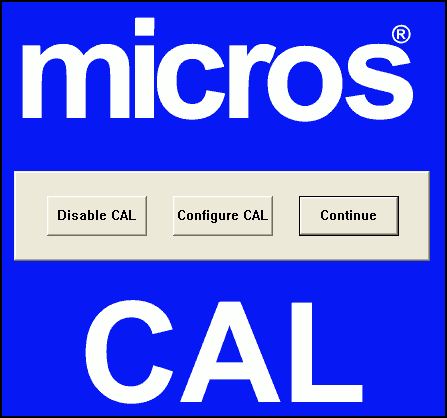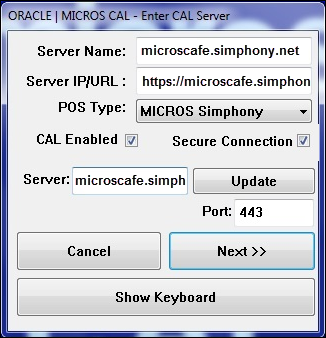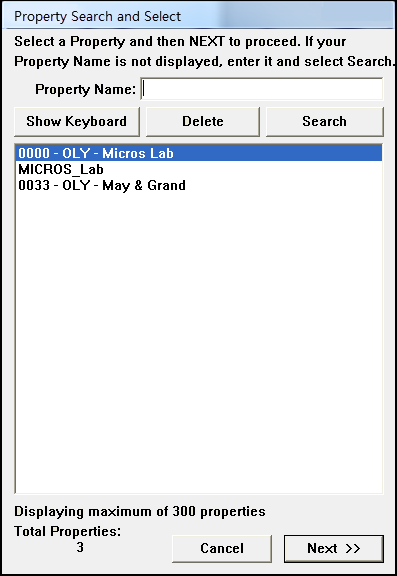Initiating CAL Authentication on the Windows Device
To initiate CAL authentication on a Windows device:
- On the device, press Start, select All Programs, select Micros Client Application Loader, and then select McrsCAL Config.
- Decipher and enter the correct access code, and then press the Configure CAL button.
Figure 9-1 MICROS CAL Screen

- In the Enter CAL Server dialog, set the following values, and then press Next:
-
Server Name: Leave this field blank.
-
Server IP/URL: Leave this field blank.
-
POS Type: Oracle recommends that you select MICROS Simphony (not Simphony Multi-Tenant), regardless whether you are running on a Simphony Standard or Premium Cloud Service environment.
-
CAL Enabled: Select this option if it is not automatically set by default.
-
Secure Connection: Select this option if Simphony uses the Translation Layer Security (TLS) 1.2 Encryption protocol. (If you are installing CAL version 139 or later, this option is set by default.)
-
Server: Enter your Simphony application server name.
-
OrgPa: If you are installing CAL version 139 in a Simphony Standard or Premium Cloud Service environment, do not enter anything, regardless of which POS Type is set.
-
Port: Enter your port number. Enter 443 if Simphony uses the TLS 1.2 Encryption protocol. (This is the default port number.)
-
Update: Click the Update button to automatically fill the Server Name and Server IP/URL fields after the application server name is resolved and recognized. You are now required to use an HTTPS secure connection in your Server URL.
Figure 9-2 Enter CAL Server Dialog

-
- Beginning with Simphony version 2.9.1, if you are installed on a Simphony Standard or Premium Cloud Service environment, CAL prompts you to enter your Simphony EMC logon credentials. Enter your User name, Password, and Organization name in the CAL Authentication dialog, and then press the Login button. If you are using Simphony (licensed) (on premises, self-hosted), you do not need to enter the Organization.
If you are using Simphony version 2.9 or earlier, you must enter the Install User Security Username and Password configured in the Security tab of the Property Parameters module in the EMC. Contact your system administrator for assistance.
- If the Enterprise has multiple properties, select the property from the Property Search and Select dialog, and then press Next.
If the property does not appear in the list, enter the property name in the Property Name field, and then press Search.
You do not see a property list if only one property is configured or if there are multiple properties, but only one property is using Windows devices.
Figure 9-3 Property Search and Select Dialog

- Select the Windows device you are configuring from the list in the Select WS Identity dialog, and then press the Save button. CAL automatically performs the initial authentication using the cached EMC credentials. The Windows device automatically restarts several times when installing the CAL package.
When CAL restarts it performs a re-authentication, and may prompt for credentials again. After validation, the POS client application starts; users can then clock in and log on to the device and resume normal functions.
Figure 9-4 Select Workstation Dialog

-
CAL version 139 can reuse an existing pre-Simphony 2.9.1 authentication when the upgrade is deployed from the Enterprise. If you run setup.exe on an existing pre-Simphony 2.9.1 installation, you need to perform initial authentication again.
-
If you change the identity of a Windows device you must perform initial authentication again.
-
Each Windows device must use a unique Service Host ID. If two devices use the same Service Host ID, the first one authenticated will lose authentication when the second is authenticated.
-
If a Windows device is only running the POS client application when you perform the initial authentication and you subsequently add CAPs to the device, you will not need to perform initial authentication again for CAPS.
-
Do not use the AuthenticationServer.exe and AuthenticateService.exe utilities for any purpose with Simphony version 2.9.1 and CAL version 139.
-